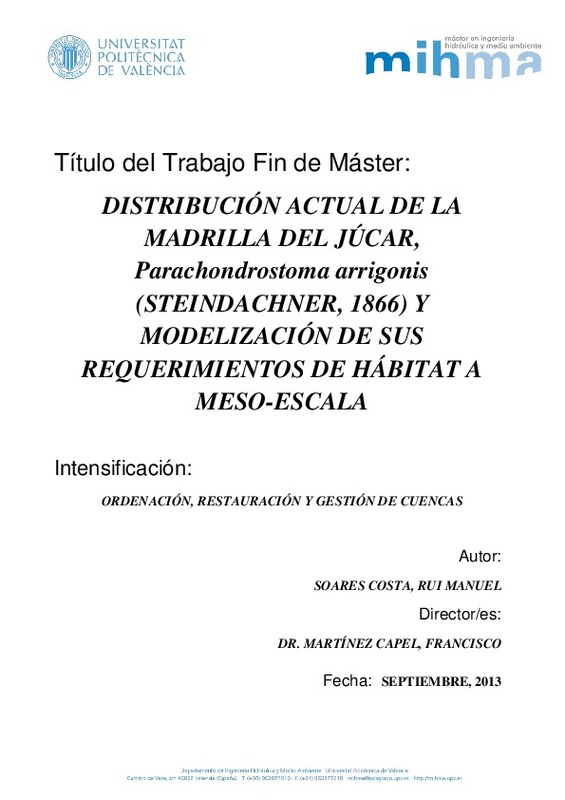JavaScript is disabled for your browser. Some features of this site may not work without it.
Buscar en RiuNet
Listar
Mi cuenta
Estadísticas
Ayuda RiuNet
Admin. UPV
Distribución actual de la Madrilla del Júcar, Parachoncrostoma arrigonis (Steindachner, 1866) y modelización de sus requerimientos de hábitat a meso-escala
Mostrar el registro sencillo del ítem
Ficheros en el ítem
| dc.contributor.advisor | Martínez Capel, Francisco
|
es_ES |
| dc.contributor.author | Soares Costa, Rui Manuel
|
es_ES |
| dc.date.accessioned | 2014-05-19T12:04:19Z | |
| dc.date.available | 2014-05-19T12:04:19Z | |
| dc.date.created | 2013-09-24 | |
| dc.date.issued | 2014-05-19 | |
| dc.identifier.uri | http://hdl.handle.net/10251/37560 | |
| dc.description.abstract | [ES] La degradación del hábitat ha reducido la complejidad de los ríos Mediterráneos en España y ha contribuido en la disminución del área de distribución de la madrilla del Júcar (Parachondrostoma arrigonis), especie catalogada como en peligro de extinción y endémica de la cuenca del río Júcar (España). La mayoría de su población vive en el río Cabriel, que se divide en dos segmentos por el embalse de Contreras. Los objetivos de este estudio fueron diagnosticar el estado actual de las poblaciones de madrilla del Júcar y desarrollar un modelo multivariado de idoneidad del hábitat (MMIH) para esta especie que pueda ser utilizado en la evaluación de caudales ambientales y escenarios de gestión del agua en el río Cabriel. Se calculó la abundancia de la especie (2006 a 2013) y se compararon las características físicas del hábitat, a escala mesohábitat (unidades hidromorfológicas, UHM), y la variabilidad entre ocho tramos de estudio. Se han desarrollado modelos aditivos generalizados (GAM) para la abundancia de peces alevines y adultos con las características del hábitat. Ambos modelos mostraron un rendimiento aceptable o bueno (R2 ajustado de 69.4 para los alevines y el 72.4 para los adultos) por lo que la abundancia de peces se utilizó como indicador de la calidad potencial del hábitat (PNH) para la madrilla del Júcar. El último paso consistió en aplicar el MMIH para evaluar el PNH en dos escenarios de regímenes de caudal ambientales y en el régimen actual en el tramo regulado situado debajo del embalse de Contreras. A partir del análisis de los datos actuales se concluye que la población de madrilla del Júcar se restringe a los ríos Cabriel, Magro y Micena (todos ellos afluentes del río Júcar). Todos los resultados apoyan la necesidad de aplicar nuevas medidas de gestión en el río Cabriel, como la aplicación de un régimen de caudales ambientales, e ilustran un procedimiento para la aplicación práctica de los modelos de selección de hábitat a escala mesohábitat | es_ES |
| dc.description.abstract | [EN] Habitat degradation has reduced the complexity of the Mediterranean streams in Spain and contributed to decreasing the historical range of the endangered Júcar nase, Parachondrostoma arrigonis. This species is endemic to the Júcar River Basin (Spain), and most of its populations live in the Cabriel River, which is divided into two segments by the large Contreras Dam. The objectives of this study were to find the actual condition of Jucar nase populations and to develop a multivariate habitat suitability model (HSM) for this species that can be used to evaluate environmental flows and water management scenarios for the Cabriel River. We first assessed the fish densities (from 2006 to 2013) and compared the habitat characteristics and variability among eight study sites based on the physical characteristics of hydromorphological units (HMUs) or mesohabitats. The abundance of the Júcar nase then was related to the HMU type, and generalized additive models of fish abundance were developed for the sites for both small and large fish. Both models showed acceptable or good performance (adjusted R2 of 69.4 for small fish and 72.4 for large fish), and fish abundance was used as an indicator of potential habitat quality (PNH) for the Júcar nase. The final step was to apply the HSM to evaluate environmentally friendly flow regimens. Hydraulic simulations were used to estimate the PNH under two flow regimen scenarios and in the actual flow regimen for the regulated study site located below the large dam. The population of Júcar nase, based on the actual data, is restricted to the rivers Cabriel, Magro and Micena (all of them tributaries of river Júcar). The results support the need for new management actions in the Cabriel River, such as implementation of an environmental flow regimen, and illustrate a procedure for the practical application of habitat selection models at the mesohabitat scale. | es_ES |
| dc.format.extent | 90 | es_ES |
| dc.language | Español | es_ES |
| dc.publisher | Universitat Politècnica de València | es_ES |
| dc.rights | Reconocimiento - No comercial - Sin obra derivada (by-nc-nd) | es_ES |
| dc.subject | Madrilla del Júcar | es_ES |
| dc.subject | Mesohábitat | es_ES |
| dc.subject | Modelos multivariados | es_ES |
| dc.subject | Idoneidad | es_ES |
| dc.subject | Júcar nase | es_ES |
| dc.subject | Multivariate models | es_ES |
| dc.subject | Suitability | es_ES |
| dc.subject.other | Máster Universitario en Ingeniería Hidráulica y Medio Ambiente-Màster Universitari en Enginyeria Hidràulica i Medi Ambient | es_ES |
| dc.title | Distribución actual de la Madrilla del Júcar, Parachoncrostoma arrigonis (Steindachner, 1866) y modelización de sus requerimientos de hábitat a meso-escala | es_ES |
| dc.type | Tesis de máster | es_ES |
| dc.rights.accessRights | Abierto | es_ES |
| dc.contributor.affiliation | Universitat Politècnica de València. Servicio de Alumnado - Servei d'Alumnat | es_ES |
| dc.description.bibliographicCitation | Soares Costa, RM. (2013). Distribución actual de la Madrilla del Júcar, Parachoncrostoma arrigonis (Steindachner, 1866) y modelización de sus requerimientos de hábitat a meso-escala. http://hdl.handle.net/10251/37560 | es_ES |
| dc.description.accrualMethod | Archivo delegado | es_ES |






